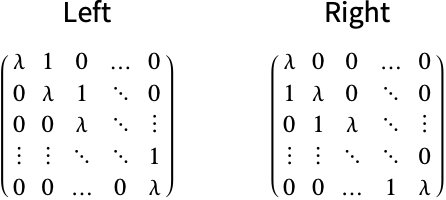JordanMatrix[λ,n]
returns a Jordan matrix with dimension n and diagonal elements λ.
JordanMatrix[λ,n,dir]
returns a Jordan matrix oriented by specification dir.


 |
JordanMatrix
JordanMatrix[λ,n]
returns a Jordan matrix with dimension n and diagonal elements λ.
JordanMatrix[λ,n,dir]
returns a Jordan matrix oriented by specification dir.
Details and Options

- Jordan matrices provide the building blocks for the Jordan decomposition of a matrix.
- JordanMatrix by default returns an n×n matrix
 with diagonal elements equal to λ and superdiagonal elements equal to 1.
with diagonal elements equal to λ and superdiagonal elements equal to 1. -

- CharacteristicPolynomial[J,x] is
 . Up to sign, so is MatrixMinimalPolynomial[J,x]. »
. Up to sign, so is MatrixMinimalPolynomial[J,x]. » - The Jordan matrix
 occurs naturally for cyclic subspaces: »
occurs naturally for cyclic subspaces: »  , …,
, …,  ,
, 
- where
 is UnitVector[n,i]. JordanDecomposition returns a block Jordan matrix of this form. »
is UnitVector[n,i]. JordanDecomposition returns a block Jordan matrix of this form. » - JordanMatrix[λ,n,dir] uses dir to determine the resulting matrix layout. It must be one of Left (the default) or Right. This directive determines whether the diagonal elements are to the left or right respective to the 1s. »
- The following option can be given:
-
TargetStructure Automatic the structure of the returned matrix - Possible settings for TargetStructure include:
-
Automatic automatically choose the representation returned "Dense" represent the matrix as a dense matrix "Sparse" represent the matrix as a sparse array "Structured" represent the matrix as a structured array

Examples
open all close allScope (4)
The first argument can be any numeric expression:
The first argument can be any purely symbolic expression:
The first argument must be a scalar:
JordanMatrix defaults to the orientation specification Left:
Options (2)
TargetStructure (2)
By default, JordanMatrix returns a dense matrix:
Instead return a SparseArray:
Check that it corresponds to the dense result:
Return an array structured as an upper triangular matrix:
Check that it corresponds to the dense result:
For TargetStructure"Structured", the type of structure depends on the direction argument:
Using Right changes the type from UpperTriangularMatrix to LowerTriangularMatrix:
Applications (1)
Construct a matrix m of nonzero entries with a doubly deficient eigenspace, a singly deficient eigenspace and a non-deficient rank-two eigenspace. Compare the Jordan decomposition of m with the matrices used to build m. First, define a ![]() Jordan matrix to represent the doubly deficient eigenspace:
Jordan matrix to represent the doubly deficient eigenspace:
Next, create a ![]() Jordan matrix for the singly deficient space:
Jordan matrix for the singly deficient space:
Finally, create a ![]() diagonal matrix for the full-rank space:
diagonal matrix for the full-rank space:
Combine these blocks into a single matrix using BlockDiagonalMatrix:
Using a similarity matrix with positive entries is likely to give nonzero entries; the following s in fact does:
The eigenvalues match the diagonal entries and dimensions of the three Jordan matrices used to build m:
The zero rows 2 and 3 of vecs show that 5 is doubly deficient, and row 5 shows that 4 is singly deficient:
Now compute JordanDecomposition[m]:
The similarity matrix computed is quite different from s—similarity matrices are not unique:
The computed Jordan matrix also differs from j:
But closer inspection shows that the blocks simply appear in different orders:
If the blocks are ordered by absolute value of the eigenvalue, the matrices are the same:
Properties & Relations (7)
CharacteristicPolynomial[JordanMatrix[λ,n],x] is ![]() :
:
MatrixMinimalPolynomial[JordanMatrix[λ,n],x] is ![]() :
:
A Jordan matrix is defined by ![]() for
for ![]() and
and ![]() :
:
With the orientation Right, the relations are ![]() for
for ![]() and
and ![]() :
:
The vectors ![]() ,
, ![]() ,
, ![]() ,
, ![]() ,
, ![]() are linearly independent:
are linearly independent:
With the orientation Right, the chain begins at ![]() rather than
rather than ![]() :
:
In more than one dimension, a Jordan matrix is non-diagonalizable:
The one-dimensional case is an exception as all ![]() matrices are diagonal:
matrices are diagonal:
In more than one dimension, a Jordan matrix is not normal:
The determinant of JordanMatrix[λ,n] is ![]() :
:
Thus, the Jordan matrix is invertible if ![]() :
:
The Jordan matrix returned by JordanDecomposition is block diagonal:
Each block is of the form JordanMatrix[λ,k] for some k:
Show that the diagonal entries of j are the eigenvalues of m, possibly in a different order:
History
Text
Wolfram Research (2025), JordanMatrix, Wolfram Language function, https://reference.wolfram.com/language/ref/JordanMatrix.html.
CMS
Wolfram Language. 2025. "JordanMatrix." Wolfram Language & System Documentation Center. Wolfram Research. https://reference.wolfram.com/language/ref/JordanMatrix.html.
APA
Wolfram Language. (2025). JordanMatrix. Wolfram Language & System Documentation Center. Retrieved from https://reference.wolfram.com/language/ref/JordanMatrix.html
BibTeX
@misc{reference.wolfram_2025_jordanmatrix, author="Wolfram Research", title="{JordanMatrix}", year="2025", howpublished="\url{https://reference.wolfram.com/language/ref/JordanMatrix.html}", note=[Accessed: 25-December-2025]}
BibLaTeX
@online{reference.wolfram_2025_jordanmatrix, organization={Wolfram Research}, title={JordanMatrix}, year={2025}, url={https://reference.wolfram.com/language/ref/JordanMatrix.html}, note=[Accessed: 25-December-2025]}